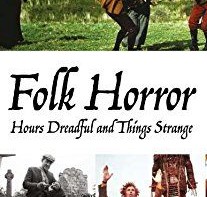From the earliest pagan offerings to the metaphysical peaks of the Romantic poets, the natural world has always been a repository for our dreams and nightmares. Alienated from our fellow creatures, we see nature as something “other”, full of hidden powers, magic, threats, portents and meanings that we can’t quite fathom. And in an era of species extinction and climate emergency, the yearning to understand our place in the natural world seems more pressing now than ever given the abundance of nature writing published in the last couple of decades.
…
Here, we cross the border and head into the territory of folk horror, which often finds its shocks and scares in the disruption of this kind of contract between people and place. In some cases, the horror stems from the violent and arcane rituals required to maintain the delicate balance of give-and-take that needs to exist between a community and the land on which it relies. Take the classic example of The Wicker Man and more recently Midsommar. In both these stories, the forces of nature are apparently appeased through sacrifice.
But in other instances, they come to punish specific offences. In David Rudkin’s 1987 television play, White Lady, the story of a single father renovating a farmhouse and teaching his two daughters the ways of the countryside is interspersed with images of animal cells mutated by the use of pesticides. In what is ostensibly a fairy tale, the man symbolises foolish humankind, while the scythe-carrying white lady of the title appears as the saviour of its next generation. “Poor sheep of a man,” she says of the girls’ father. “Once, long ago, he lost the land he lived from, next he lost his country, now he is losing the earth.” His punishment for allowing the world to be poisoned is for his daughters to be taken from him and replaced by changelings. His is the last generation. Through their destructive actions, humans have forfeited their right to exist.
A far more hostile entity appears in Lee Haven Jones’ 2021 Welsh-language film Gwledd (The Feast), in which a long-dead spiritual guardian of the land returns in the guise of a young girl, Cadi, to exact a gruesome revenge upon a family and their business associates who are plundering ancient ground for its mineral wealth. In these instances, the land is anthropomorphised. But in other cases, it plays its strange self. In Ben Wheatley’s In the Earth, a scientist is consumed by madness as he attempts to commune with nature via a standing stone. While in the 2013 film, The Borderlands, a research group investigating an alleged miracle in a remote church discover that it has been built upon a labyrinth of tunnels which become increasingly – and in the end quite literally – digestive, as two of the party are dissolved by what appears to be hydrochloric acid.
The dangers of what lurks under the soil are sounded again and again throughout horror fiction and film, from Grant Allen’s Pallinghurst Barrow to MR James’s A Warning to the Curious to Piers Haggard’s The Blood on Satan’s Claw to my own novel, Starve Acre. Here, there is a penalty to be paid for disturbing the earth. Whereas in other cases, the natural world acts with malevolence for no discernible reason at all. In Daphne du Maurier’s The Birds, Nat, the main protagonist wonders, “how many million years of memory were stored in those little brains, behind the stabbing beaks, the piercing eyes, now giving them this instinct to destroy mankind with all the deft precision of machines.” While Peter Weir’s dream-like Picnic at Hanging Rock sees three schoolgirls from Appleyard College spirited into (or by) the Australian wilderness for reasons unknown.



Anyone with seasonal allergies knows that nature wants to kill us.